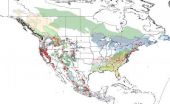(Press-News.org) Vegetation growth at Earth's northern latitudes increasingly resembles lusher latitudes to the south, according to a NASA-funded study based on a 30-year record of land surface and newly improved satellite data sets.
An international team of university and NASA scientists examined the relationship between changes in surface temperature and vegetation growth from 45 degrees north latitude to the Arctic Ocean. Results show temperature and vegetation growth at northern latitudes now resemble those found 4 degrees to 6 degrees of latitude farther south as recently as 1982.
"Higher northern latitudes are getting warmer, Arctic sea ice and the duration of snow cover are diminishing, the growing season is getting longer and plants are growing more," said Ranga Myneni of Boston University's Department of Earth and Environment. "In the north's Arctic and boreal areas, the characteristics of the seasons are changing, leading to great disruptions for plants and related ecosystems."
The study was published Sunday, March 10, in the journal Nature Climate Change.
Myneni and colleagues used satellite data to quantify vegetation changes at different latitudes from 1982 to 2011. Data used in this study came from NOAA's Advanced Very High Resolution Radiometers (AVHRR) onboard a series of polar-orbiting satellites and NASA's Moderate Resolution Imaging Spectroradiometer (MODIS) instruments on the Terra and Aqua satellites.
As a result of enhanced warming and a longer growing season, large patches of vigorously productive vegetation now span a third of the northern landscape, or more than 3.5 million square miles (9 million square kilometers). That is an area about equal to the contiguous United States. This landscape resembles what was found 250 to 430 miles (400 to 700 kilometers) to the south in 1982.
"It's like Winnipeg, Manitoba, moving to Minneapolis-Saint Paul in only 30 years," said co-author Compton Tucker of NASA's Goddard Space Flight Center in Greenbelt, Md.
The Arctic's greenness is visible on the ground as an increasing abundance of tall shrubs and trees in locations all over the circumpolar Arctic. Greening in the adjacent boreal areas is more pronounced in Eurasia than in North America.
An amplified greenhouse effect is driving the changes, according to Myneni. Increased concentrations of heat-trapping gasses, such as water vapor, carbon dioxide and methane, cause Earth's surface, ocean and lower atmosphere to warm. Warming reduces the extent of polar sea ice and snow cover, and, in turn, the darker ocean and land surfaces absorb more solar energy, thus further heating the air above them.
"This sets in motion a cycle of positive reinforcement between warming and loss of sea ice and snow cover, which we call the amplified greenhouse effect," Myneni said. "The greenhouse effect could be further amplified in the future as soils in the north thaw, releasing potentially significant amounts of carbon dioxide and methane."
To find out what is in store for future decades, the team analyzed 17 climate models. These models show that increased temperatures in Arctic and boreal regions would be the equivalent of a 20-degree latitude shift by the end of this century relative to a period of comparison from 1951-1980.
However, researchers say plant growth in the north may not continue on its current trajectory. The ramifications of an amplified greenhouse effect, such as frequent forest fires, outbreak of pest infestations and summertime droughts, may slow plant growth.
Also, warmer temperatures alone in the boreal zone do not guarantee more plant growth, which also depends on the availability of water and sunlight.
"Satellite data identify areas in the boreal zone that are warmer and dryer and other areas that are warmer and wetter," said co-author Ramakrishna Nemani of NASA's Ames Research Center in Moffett Field, Calif. "Only the warmer and wetter areas support more growth."
"We found more plant growth in the boreal zone from 1982 to 1992 than from 1992 to 2011, because water limitations were encountered in the later two decades of our study," said co-author Sangram Ganguly of the Bay Area Environmental Research Institute and NASA Ames.
INFORMATION:
Data, results and computer codes from this study will be made available on NASA Earth Exchange (NEX), a collaborative supercomputing facility at Ames Research Center, Moffett Field, Calif. NEX is designed to bring scientists together with data, models and computing resources to accelerate research and innovation and provide transparency.
Amplified greenhouse effect shifts north's growing seasons
2013-03-11
ELSE PRESS RELEASES FROM THIS DATE:
Nerve damage may underlie widespread, unexplained chronic pain in children
2013-03-11
Massachusetts General Hospital (MGH) investigators have described what may be a newly identified disease that appears to explain some cases of widespread chronic pain and other symptoms in children and young adults. Their report that will appear in the April issue of the journal Pediatrics, and has received early online release, finds that most of a group of young patients seen at the MGH for chronic, unexplained pain had test results indicating small-fiber polyneuropathy, a condition not previously reported in children. The MGH investigators call this new syndrome juvenile-onset ...
Study: Antibiotics are unique assassins
2013-03-11
In recent years, a body of publications in the microbiology field has challenged all previous knowledge of how antibiotics kill bacteria. "A slew of papers came out studying this phenomenon, suggesting that there is a general mechanism of killing by antibiotics," said Kim Lewis, Northeastern University Distinguished Professor in the Department of Biology and director of Northeastern's Antimicrobial Discovery Center.
The standard thinking at the time was that the three main classes of bactericidal antibiotics each had a unique way of killing ...
The household carbon emission per capita in Northwestern China is only 2.05 tons CO2 per year
2013-03-11
The current international climate policy framework is mainly based on the national and regional level of macroscopic carbon emissions data, such as the regional per capita carbon emissions are often used as the indicator to measure the fairness of carbon emission rights. However, the per capita emissions based on regional macro data can not accurately reveal the low carbon emissions of the poor within the region, and cover up the emission differences among people intra-country and intra-region, the household carbon emission data based on field surveys could compensate for ...
Why people put themselves under the knife
2013-03-11
In a long-term study, Prof. Dr. Jürgen Margraf, Alexander von Humboldt Professor for Clinical Psychology and Psychotherapy at the RUB, investigated the psychological effects of plastic surgery on approximately 550 patients in cooperation with colleagues from the University of Basel. Patients demonstrated more enjoyment of life, satisfaction and self-esteem after their physical appearance had been surgically altered. The results of the world's largest ever study on this issue are reported by the researchers in the journal "Clinical Psychological Science".
The aim of the ...
Environmental change impacts on migratory shorebirds differ for males and females
2013-03-11
Extensive shell fishing and sewerage discharge in river estuaries could have serious consequences for the rare Icelandic black-tailed godwits that feed there. But it is the males that are more likely to suffer, according to new research from the University of East Anglia.
Research published today in the journal Ecology and Evolution reveals very different winter feeding habits between the sexes.
Both males and females mainly consume bivalve molluscs, sea snails and marine worms, probing vigorously into soft estuary mud with their long beaks. But the study shows that ...
Coffee and tea during pregnancy affect fetal growth
2013-03-11
Drinking just two cups of coffee a day is associated with the risk of low birth weight. Researchers at Sahlgrenska Academy, University of Gothenburg, Sweden, have conducted a study on 59,000 women in collaboration with the Norwegian Institute of Public Health.
Expectant mothers who consume caffeine, usually by drinking coffee, are more likely to have babies with lower birth weight than anticipated, given their gestational age. Researchers at Sahlgrenska Academy, University of Gothenburg, conducted a study on 59,000 pregnant Norwegian women in collaboration with the Norwegian ...
Evolution in the antibody factory
2013-03-11
This press release is available in German.
Immune system B cells play a crucial role in the defence of pathogens; when they detect such an intruder, they produce antibodies that help to combat the enemy. They concurrently and continuously improve these molecules to more precisely recognize the pathogens. A team of scientists with participation of the Helmholtz Centre for Infection Research (HZI) has discovered that during this process the cells are able to advance their own evolution themselves by increasing the selection pressure through previously-produced antibodies. ...
Neck injuries linked to high costs for patients and spouses, reports study in Spine
2013-03-11
Philadelphia, Pa. (March 11, 2013) - Patients with neck injuries incur increased health and social costs—which also affect their spouses and may begin years before the initial injury, reports a study in the March 1 issue of Spine. The journal is published by Lippincott Williams & Wilkins, a part of Wolters Kluwer Health.
Some individuals and families seem more susceptible to experiencing socioeconomic consequences of neck injury, according to the new research by Dr Poul Jennum of University of Copenhagen and colleagues. Particularly for patients who develop chronic ...
NUS graphene researchers create 'superheated' water that can corrode diamonds
2013-03-11
A team of researchers from the National University of Singapore (NUS) led by Professor Loh Kian Ping, Head of the Department of Chemistry at the NUS Faculty of Science, has successfully altered the properties of water, making it corrosive enough to etch diamonds. This was achieved by attaching a layer of graphene on diamond and heated to high temperatures. Water molecules trapped between them become highly corrosive, as opposed to normal water.
This novel discovery, reported for the first time, has wide-ranging industrial applications, from environmentally-friendly degradation ...
Researchers develop tools for discovering new species
2013-03-11
AMHERST, Mass. – For hundreds of years, naturalists and scientists have identified new species based on an organism's visible differences. But now, new genetic techniques are revealing that different species can show little, to no visible differences.
In a just-published study, evolutionary biologists at the University of Massachusetts Amherst and the American Museum of Natural History (AMNH) combine traditional morphological tests plus genetic techniques to describe new species. Groups of morphologically similar organisms that show very divergent genetics are generally ...




